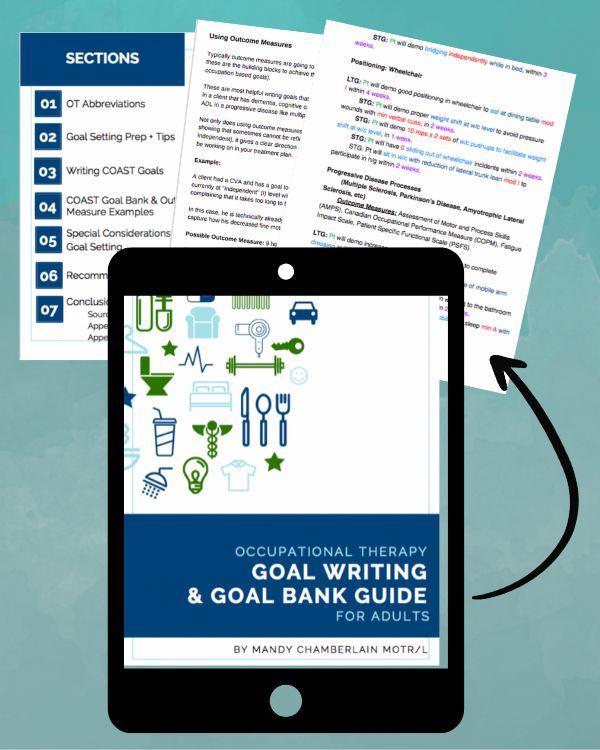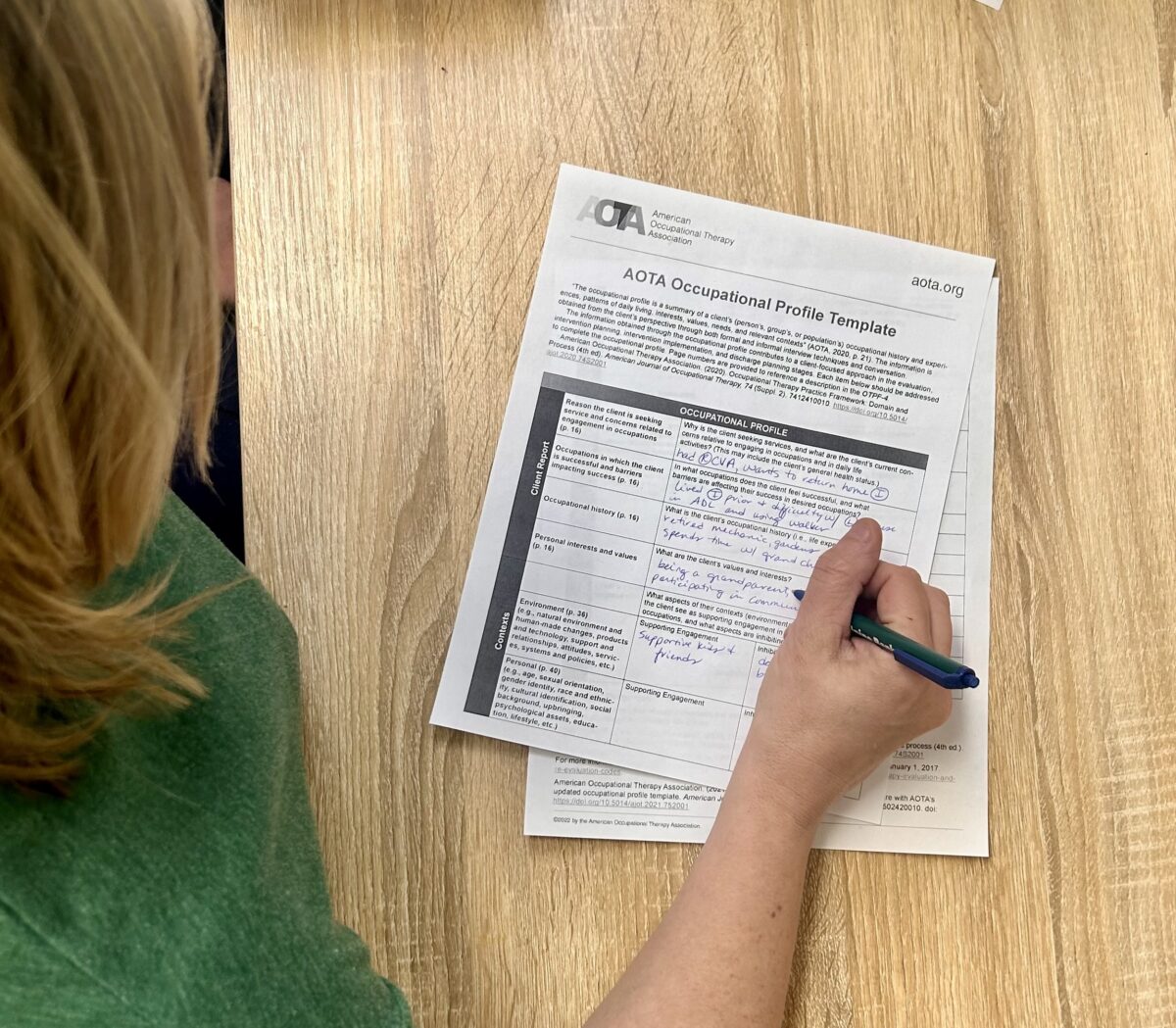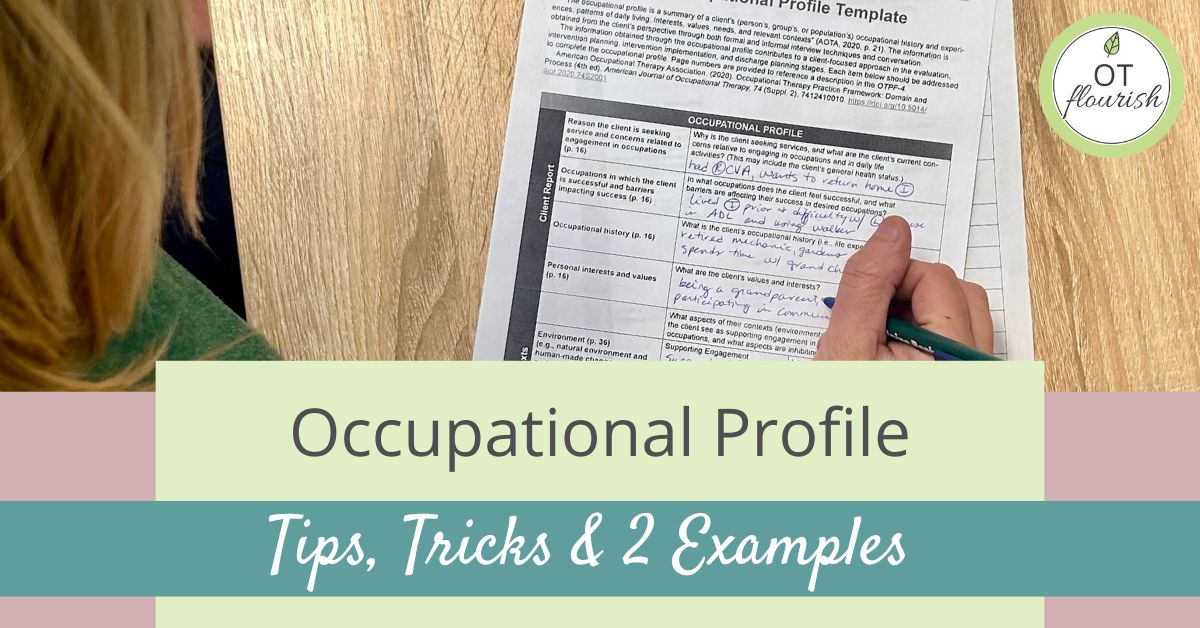Are you integrating the AOTA Occupational Profile into your practice?
This powerful tool has the potential to revolutionize the way you provide client-centered care and elevate your practice. The occupation profile for occupational therapy practitioners (OTPs) serves as a foundational tool for gathering comprehensive information about clients’ backgrounds, interests, and goals, guiding the development of personalized intervention plans. According to the 4th edition of the Occupational Therapy Practice Framework: Domain and Process (OTPF-4) released by the American Occupational Therapy Association (AOTA) in 2020, each occupational therapy (OT) evaluation incorporates both the occupational profile and the analysis of occupational performance.
In this article, we will explore:
- the purpose of the Occupational Profile
- how to effectively utilize it in practice,
- the benefits of incorporating it into your work
- tips for maximizing its impact, and
- an occupational profile example
Key Components of the AOTA Occupational Profile:
The AOTA (American Occupational Therapy Association) Occupational Profile is a foundational document used by occupational therapy practitioners to gather essential information about their clients at the outset of the therapeutic process. It serves as a comprehensive overview of the client’s occupational history, interests, strengths, limitations, and goals. The Occupational Profile helps OTPs gain insight into the client’s unique needs, preferences, and circumstances, which in turn informs the development of personalized intervention plans tailored to promote optimal engagement in meaningful activities and improve overall quality of life.
AOTA Occupational Profile Template
What is Included in an Occupational Profile?
Occupational History: This section explores the client’s past and current engagement in activities of daily living (ADLs), instrumental activities of daily living (IADLs), work, leisure, and social participation. It includes details about the client’s roles, routines, habits, and rituals, as well as any significant life events or transitions that may impact their occupational performance.
Reason for Seeking Services: OTPs inquire about the client’s primary concerns, challenges, or goals that prompted them to seek occupational therapy services. Understanding the client’s perceived difficulties or areas of dissatisfaction helps prioritize intervention goals and guide the therapeutic process effectively.
Client’s Priorities, Interests, and Values: OTPs explore the activities and occupations that are meaningful and significant to the client. This includes identifying activities the client enjoys, values, or wishes to resume or pursue. Understanding the client’s interests and values facilitates the development of client-centered intervention plans that promote motivation and engagement.
Client’s Roles and Responsibilities: OTPs gather information about the various roles the client assumes in their personal, family, social, and community contexts. This includes roles such as parent, spouse, caregiver, employee, student, or community member. Understanding the demands and expectations associated with these roles helps OTs address role-related challenges and promote participation and satisfaction.
Client Factors: This section encompasses the client’s personal characteristics, including physical, cognitive, emotional, and sensory factors that may influence their occupational performance. OTPs assess the client’s strengths, abilities, limitations, and any contextual factors that may impact their engagement in daily activities.
Performance Patterns: OTPs examine the client’s patterns of engagement in daily activities, including habits, routines, rituals, and roles. Understanding how the client typically organizes their time, manages tasks, and copes with challenges provides valuable insights for intervention planning.
Contextual Factors: OTPs consider the environmental and contextual factors that influence the client’s occupational performance. This includes aspects of the physical environment (e.g., home, work, community), social environment (e.g., support networks, relationships), cultural factors, and socioeconomic factors. Recognizing and addressing contextual barriers or facilitators is essential for promoting successful outcomes.
Client Goals: OTPs collaborate with the client to establish meaningful and achievable goals that reflect their desired outcomes for occupational therapy.
COAST goals, which stand for Client, Occupation, Assistance level, Specific conditions, and Timeline, are a framework used in occupational therapy to develop specific and measurable goals tailored to the individual needs and circumstances of clients. These guide the development and evaluation of plans of care (POC).
Need help writing COAST goals or looking for a goal bank?
Buy the Goal Writing & Goal Bank Guide here ![]()
![]()


Understanding the Purpose of the AOTA Occupational Profile
To fully understand the impact and importance of the AOTA Occupational Profile, it is essential to grasp its purpose within the realm of occupational therapy practice. By delving into the core objectives of this tool, practitioners can hone their skills in providing personalized care that truly meets the unique needs of their clients.
Utilizing the AOTA Occupational Profile in Practice
The Occupation Profile for occupational therapists helps to gain a deeper understanding of their clients’ individual needs, preferences, and goals. By systematically collecting this valuable information, therapists can tailor their interventions to specifically address the areas that are most important to each client. This process not only enhances the quality of care provided but also fosters a strong therapeutic relationship based on trust, empathy, and collaboration. Ultimately, the AOTA Occupational Profile serves as a foundation for guiding treatment planning and decision-making, ensuring that interventions are meaningful, effective, and client-centered.
Furthermore, the CPT® codes for occupational therapy evaluation and re-evaluation introduced in 2017 mandate the incorporation of an occupational profile.
Benefits of Incorporating the Occupational Profile
By incorporating the AOTA Occupational Profile into their practice, occupational therapists can gain valuable insights into their clients’ individual needs and preferences. This allows for a customized approach to interventions, tailored to address the areas that matter most to each client. This, in turn, leads to a higher quality of care and helps to establish a strong therapeutic relationship built on trust and collaboration. Ultimately, the AOTA Occupational Profile serves as a crucial tool for guiding treatment planning and decision-making, ensuring that interventions are not only meaningful but also effective and client-centered. This comprehensive understanding of the client enhances the therapist’s ability to provide targeted and impactful interventions, maximizing the overall effectiveness of the therapy process.
_______________________________________________________________________
Want a pdf list of treatment activities to use with the occupational profile and ways to grade each activity?
Sign up below and get access to this and all the resources available in the Free Level of the OT Accelerator


How Do You Write an Occupational Profile?
Example Occupational Profile of a Patient in a Skilled Nursing Facility
Name: Mr. John Smith
Age: 75
Medical History: Mr. Smith was admitted to the nursing home three weeks ago following a stroke. He presents with left-sided weakness, decreased mobility, and difficulty performing activities of daily living independently. He has a history of hypertension and diabetes, managed with medication.
1. Occupational History: Mr. Smith was previously living independently in his own home. He worked as a mechanic before retirement and enjoyed gardening, woodworking, and spending time with his grandchildren. He was actively involved in his community, attending church services regularly and participating in social clubs.
2. Reason for Seeking Services: Mr. Smith is seeking occupational therapy services to regain independence in his daily activities following his stroke. He expresses frustration with his current limitations and desires to be able to perform tasks such as dressing, grooming, and feeding himself without assistance.
3. Client’s Priorities, Interests, and Values: Mr. Smith values his independence and expresses a strong desire to return home and resume his previous activities. He is particularly motivated to be able to engage in woodworking again, as it has been a lifelong passion for him. He enjoys spending time with his family and hopes to be able to participate in family gatherings and outings once he is more mobile.
4. Client’s Roles and Responsibilities: In addition to being a retired mechanic, Mr. Smith is a widower and a father of two adult children. He has a supportive network of family and friends who visit him regularly in the nursing home. He expresses a sense of responsibility towards maintaining his independence and not burdening his family with his care needs.
5. Client Factors: Mr. Smith presents with right-sided hemiparesis, resulting in decreased strength and coordination on his right side. He also experiences mild cognitive deficits, particularly with attention and problem-solving. Despite these challenges, he remains highly motivated and determined to participate in therapy and regain his independence.
6. Performance Patterns: Prior to his stroke, Mr. Smith had a structured daily routine that included morning walks, gardening in the afternoons, and woodworking in his garage. Since his admission to the nursing home, his routine has been disrupted, and he struggles to adapt to the new environment and schedule.
7. Contextual Factors: The nursing home environment poses several challenges for Mr. Smith, including limited space and equipment for therapeutic activities. Additionally, he experiences occasional frustration with the slower pace of care in the nursing home compared to his previous independent lifestyle at home.
8. Client Goals: Mr. Smith’s primary goals include regaining independence in activities of daily living, improving mobility and strength on his right side, and ultimately returning home. He also hopes to resume woodworking and gardening activities once he is discharged from the nursing home.


Occupational Profile Example of a Patient in Home Health
Name: Mrs. Maria Rodriguez
Age: 68
Medical History: Mrs. Rodriguez recently underwent total knee replacement surgery due to severe osteoarthritis. She lives alone in her apartment and receives home healthcare services following her discharge from the hospital.
1. Occupational History: Mrs. Rodriguez worked as a teacher before retiring. She enjoys reading, cooking traditional meals, and spending time with her grandchildren. Prior to her knee surgery, she was independent in her daily activities and took pride in maintaining her home.
2. Reason for Seeking Services: Mrs. Rodriguez seeks occupational therapy services to regain independence in her daily activities following her knee replacement surgery. She expresses frustration with her current limitations in mobility and desires to be able to perform household tasks and self-care activities without assistance.
3. Client’s Priorities, Interests, and Values: Mrs. Rodriguez values her ability to maintain her independence and remain active in her community. She is eager to return to her usual activities, including cooking meals for her family and attending social gatherings with friends. She expresses a strong desire to be able to walk without pain and resume her gardening hobby.
4. Client’s Roles and Responsibilities: In addition to being a retired teacher, Mrs. Rodriguez is a mother of two adult children and a grandmother of four. She takes pride in her role as a caregiver and enjoys spending time with her family. She expresses a sense of responsibility towards managing her own health and well-being.
5. Client Factors: Mrs. Rodriguez presents with limited mobility and pain in her right knee following surgery. She also experiences mild stiffness and weakness in her lower extremities. Despite these challenges, she remains motivated to participate in therapy and regain her independence.
6. Performance Patterns: Prior to her surgery, Mrs. Rodriguez had a structured daily routine that included cooking meals, doing light housework, and attending social events. Since her surgery, her routine has been disrupted, and she struggles to adapt to the physical limitations imposed by her recovery.
7. Contextual Factors: The home environment poses several challenges for Mrs. Rodriguez, including limited space and accessibility issues. She also experiences anxiety about navigating stairs and using her walker safely. Additionally, she expresses concerns about relying on others for assistance with tasks she used to perform independently.
8. Client Goals: Mrs. Rodriguez’s primary goals include improving mobility and strength in her right knee, regaining independence in activities of daily living, and returning to her pre-surgery level of function. She also hopes to resume cooking meals for her family, attending social gatherings, and gardening once she has recovered fully.
These real-life examples highlight the transformative power of the AOTA Occupational Profile when used effectively in occupational therapy practice. By grounding interventions in a deep understanding of each client’s unique circumstances and aspirations, therapists can deliver targeted, person-centered care that fosters meaningful outcomes. As more practitioners embrace the principles of the Occupational Profile and incorporate it into their practice where the power of personalized care and easier goal setting shines through in every interaction.
“The power of the occupational profile lies not just in its completion, but in its transformation of client care.”







